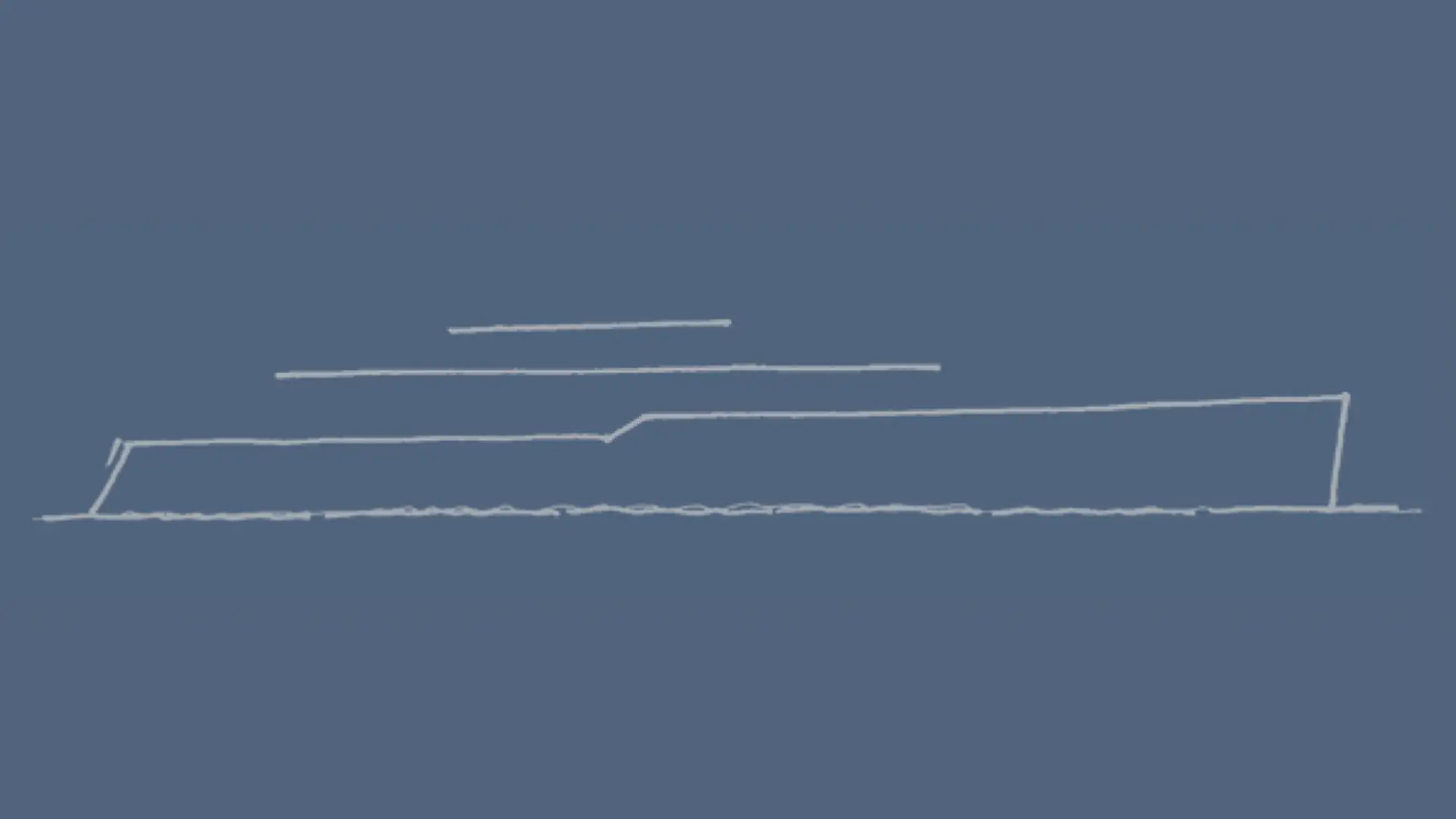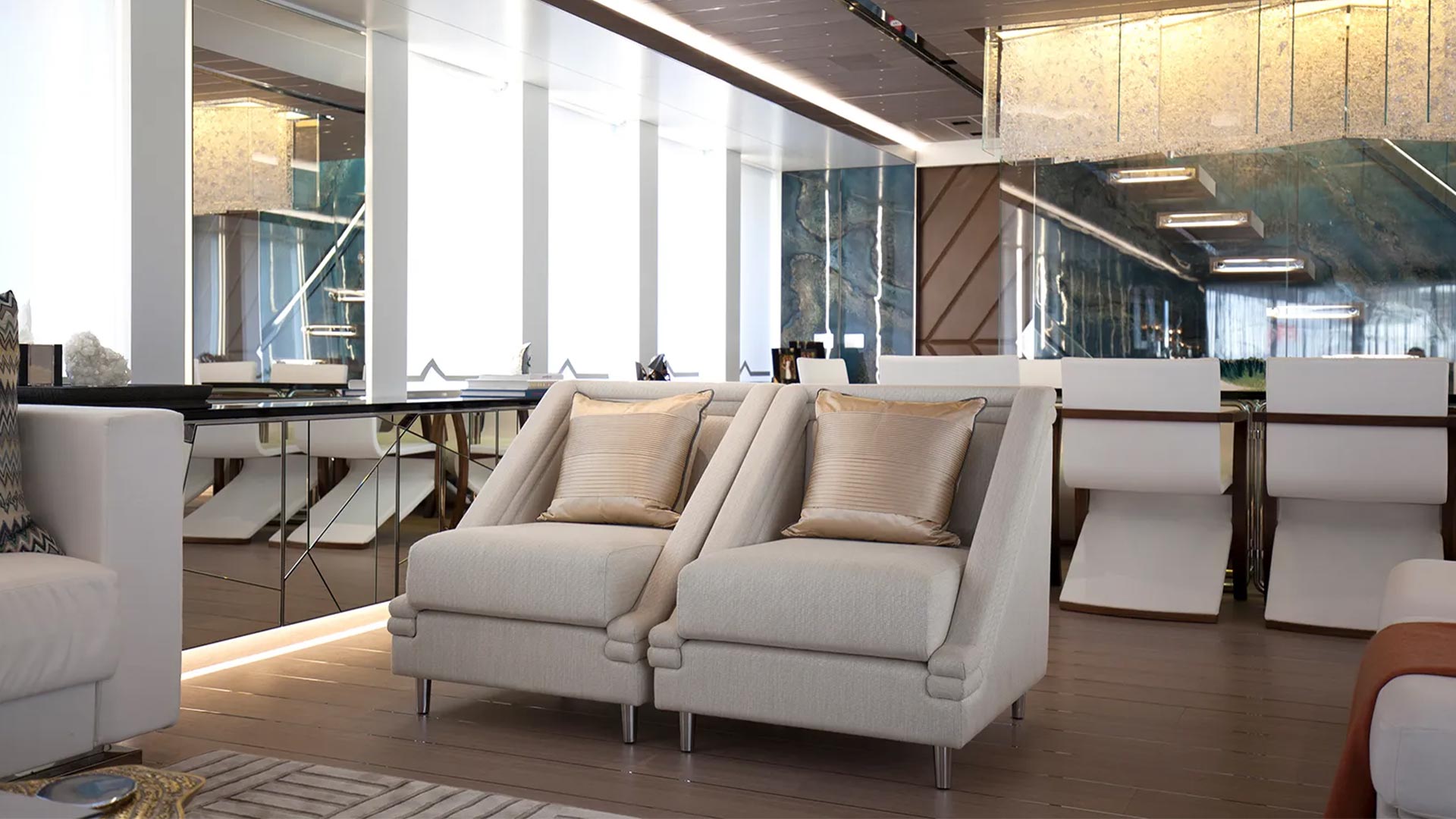All in a design package that exudes classic style and grace with a modern twist for a pure, elegant, sophisticated and yet subtle design combined with the top-level security criteria and devices.
The spirit, energy and passion of our team meant we were able to identify winning solutions and achieve higher functional and aesthetic standards, which successfully lead to the Logica 147, a masterpiece exceeding my highest expectations. Such success is a prelude of more to come, and a 180-foot yacht is already in the initial design and engineering stages.
As a means of promotion, I am in the process of inviting yachting professionals, well-known personalities and potential customers to savour the Logica 147’s comfort and beauty. It’s quietness and absence of vibration while sailing at night goes well beyond our initial expectations and guests can sleep soundly even while cruising at over 13 knots.
The magnificently spacious outdoor spaces are simply amazing, as is the small gym, hammam, and 2.6m x 5.5m swimming pool equipped with a counter current and Jacuzzi. In terms of interior space with its six cabins and American-style galley, this 45m yacht matches that of many 55m yachts.
Simply put, the Logica 147 is a truly timeless yacht.
Eliott Aintabi,
President

Distinctly Mediterranean
Together with my team, we imagined a navetta-style vessel that was comfortable, quiet and light-field with a rational distribution of available space, a boat designed to make the most of everything the Med has to offer
As says Luca Brenta, an active sailor since the age of five. « Logica had to be as beautiful as a sailboat ot equivalent length, but as roomy and comfortable as three of them. »
This was the inspiration and the ethos behind the Logica 147. Derived from the studio’s renowned work in sailboat design, the idea behind the yacht’s elegant exterior styling was to import the culture and values o† Mediterranean salling into the world of displacement cruising to appeal to owners who are genuinelv passionate about yachting and the sea.
Logica 147’s exterior designer

The studio’s sailing yacht projects are defined by their pure and clean exterior lines, a reflection also of their cutting-edge performance
But the design brief for the Logica 147 called for a different set of criteria: comfort rather than top-speed performance and the romance of classic design combined with contemporary appeal. At the same time the exterior form had to be as much an expression of its function as it would for a sailing yacht.

If you start from the bow and work your way backward the design has a coherence and fluidity with no surprises or jarring elements.
As Brenta says, pencil in hand. The bow and sheer line are among the most defining features of any motoryacht; these have been emphasised on the Loqica 147 with a near-plumb stem and by pushing the superstructure as far aft as possible. The challenge was how to achieve a low profile and balanced lines on a tri-decker of nearly 45 metres in length. The solution was to design a long, sweeping sheer line interrupted amidships with just one step-down and a low-slung superstructure that emphasises horizontal over vertical planes. A late addition was the cut-out in the forward section of the hull that allows natural light to flood the owner’s suite.

The generous space freed up on the foredeck is taken up by a 5.5-metre contra-flow swimming pool.
To leave the upper deck clean and uncluttered of tenders and toys, the pool is flanked by a covered bay for a 4.8m RIB (the 6m limo tender is housed in a side-loading garage forward of the engine room) and another bay to accommodate the jet skis and launch crane. Rather than hinging the carbon composite and teak-clad hatch covers, which would have required a bigger crane to lift the toys over the top of them, an ingenious hydraulic system was engineered so the covers slide one above the other over the pool.


The superstructure was designed to create long sightlines through the yacht and maximise contact with the marine environment.
The main deck is enclosed b a curtain of glass windows to allow plentiful natural light in and panoramic views out, while the transom can be folded down and transformed into a larqe swim platform for easy access to the sea.
Opulent Minimalism
I’m a creative person, so I feel challenged and charged by a creative brief
I was particularly gratified with this project because of the stimulating brief from the owner, who I had already worked with in the past on a residential project. Superyacht interiors are not simple, but I like to think we get it right in terms of attention to detail and the logic of the design.
As Martin Kemp says, the studio founder.


The Logica 147, his first solo interior yacht project, also benefitted from his previous experience in the construction of two superyachts.
The brief called for a luxurious yet light and cheerful interior style, which Kemp describes as « opulent minimalism. » It draws on luxurious materials such as Macassar Ebony, Striato Apuano and Cosmic Black marbles, combined with refined lacquered finishes that are anchored by calming floors and ceilings of stained oak with polished stainless steel « caulking. »

The overall effect reflects the contemporary exterior styling and has been enriched with products by top international luxury brands.
Based Upon in London was commissioned to create metallic resin wall panels of a striking petrol blue, which provide a signature motif in the main deck living areas. Soft leathers supplied by the likes of Ben Whistler and J. Robert Scott in the quest cabins are married with luscious fabrics by Sahco in Germany and Holly Hunt in the USA. The custom designed carpets are by Matthew Wailes in London, while the bespoke lamps and lighting fixtures are from Altraluce in Italy, Carlyle in New York and Haberdashery in London. The result is a delicious smorgasbord of materials, finishes and textures that delight and stimulate the senses.

The lighting has also been creatively designed to provide functional illumination and enrich the interior ambience.
On the ceiling in the owner’s cabin, for example, a slim dimmable LED panel of thin plastic sheet, based on innovative technology by Promotech, diffuses light uniformly over its entire surface to deliver a more customised lighting solution. Backlighting through opaque or translucent materials overcomes the limitations of the concentrated light source from traditional spotlights, allowing more natural illumination and avoiding areas of shadow to provide visual comfort on a par with daylight.

Martin Kemp has not overlooked the more practical elements.
The owner has a young family, for example, and was keen to avoid any potentially painful sharp corners. Lacquer is susceptible to scratching, but Kemp points out that it is also a very hard finish, while the patterned leather door panels will develop a subtle patina, which is part of the appeal of a natural material that gently ages over time.
integrated optimisation
Pierluigi Ausonio of PLANA Design is the naval architect behind the Logica 147.
Together with the shipyard, he adopted a process of integrated optimisation to determine the design of the hull, appendages and propellers.
In the past, the process of designing motoryacht hulls was considered as much an art as a science, something akin to the exterior design or styling. In reality, the hydrodynamic design of an efficient hull, no matter the kind – full displacement, fast displacement, semi-planing or full-planing – requires in-depth technical knowledge in addition to some degree of « feeling » for flow-related problems.
Nowadays, hull design is a highly specialised discipline and one that Ausonio arques is best carried out in the context of the whole design process.
« The naval architect is frequently appointed by the shipyard to define the hull form alone, without an in-depth analysis of the whole project, he explains. « However, the complexity of a modern motoryacht is such that in designing the hull you have to take into account not only the performance-related aspects (speed, range, sea-keeping, manoeuvrability) and the control of undesired side-effects (noise, vibration), but also the safety and habitability standards required by Classification societies and Flag administrations, especially if you are dealing with a commercial charter yacht. Last but not least, there are the interior layout requirements that have to be respected. In other words, to achieve the best results the hydrodynamic design should be an activity that is fully integrated into the design of the whole yacht. »

The Logica 147 was developed with this process of integrated optimisation in mind and PLANA Design was appointed to carry out the full hull design
Including hydrodynamic, hydrostatic and stability evaluations, appendage optimisation, propulsion study and the preliminary propeller design.

The shape, size and position of the hull appendages were other important aspects of the hydrodynamic optimisation process,
As today’s motoryachts are equipped not only with rudders, shaft lines and brackets, but also underwater exhaust scoops, large zero-speed stabiliser fins, bow and sometimes stern thrusters and, in some cases, bilge keels.
building the best
The hull and superstructure are joined using a system known as DeltaCoupling
By which steel and aluminium strips are explosively bonded to an inert centre section to avoid degradation of the two dissimilar metals in a saline environment.
The engine room is the beating heart of any motoryacht, so great emphasis was placed on providing insulated foundations and flexible joints for the main machinery to reduce noise and vibration, and utilising the best materials such as cupro-nickel and stainless steel for the piping.
Safety was another all-important factor, and multiple redundancy has been designed into the technical specifications.
Moreover, the wheelhouse features a Böning integrated bridge; the zero-speed stabilisers are by Vosper Naiad; there is a user-friendly Yachtica automated contro system for lighting, curtains and AC throughout the guest areas; home entertainment components are by Denon, Samsung and Apple; the galley is equipped with professional Rational and Miele appliances; and the deck gear is supplied by Opem Sistemi.
« These are all leading brands in their various fields and no expense was spared in specifying the best solutions for the job, » concludes Marconcini.




